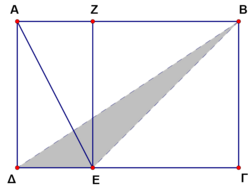Difference between revisions of "2006 Cyprus MO/Lyceum/Problem 14"
I like pie (talk | contribs) (Standardized answer choices) |
(solution with note) |
||
| (One intermediate revision by one other user not shown) | |||
| Line 2: | Line 2: | ||
[[Image:2006 CyMO-14.PNG|250px|right]] | [[Image:2006 CyMO-14.PNG|250px|right]] | ||
| − | The rectangle <math>AB\Gamma \Delta</math> is a small garden divided to the rectangle <math>AZE\Delta</math> and to the square <math>ZB\Gamma E</math>, so that <math>AE=2\sqrt{5}m</math> and the shaded area of the triangle <math>\Delta BE</math> is <math> | + | The rectangle <math>AB\Gamma \Delta</math> is a small garden divided to the rectangle <math>AZE\Delta</math> and to the square <math>ZB\Gamma E</math>, so that <math>AE=2\sqrt{5}\ \text{m}</math> and the shaded area of the triangle <math>\Delta BE</math> is <math>4\ \text{m}^2</math>. The area of the whole garden is |
<math>\mathrm{(A)}\ 24\ \text{m}^2\qquad\mathrm{(B)}\ 20\ \text{m}^2\qquad\mathrm{(C)}\ 16\ \text{m}^2\qquad\mathrm{(D)}\ 32\ \text{m}^2\qquad\mathrm{(E)}\ 10\sqrt{5}\ \text{m}^2</math> | <math>\mathrm{(A)}\ 24\ \text{m}^2\qquad\mathrm{(B)}\ 20\ \text{m}^2\qquad\mathrm{(C)}\ 16\ \text{m}^2\qquad\mathrm{(D)}\ 32\ \text{m}^2\qquad\mathrm{(E)}\ 10\sqrt{5}\ \text{m}^2</math> | ||
==Solution== | ==Solution== | ||
| − | {{ | + | The area of triangle <math>\Delta BE</math> is equal to the area of triangle <math>\Delta AE</math>, so the area of rectangle <math>\Delta AZE</math> is <math>4*2=8</math>. Let <math>AZ=x</math> and <math>XE=y</math>. <math>xy=8</math>, and <math>x^2+y^2=20</math>. Thus |
| + | |||
| + | <math>(x+y)^2=x^2+y^2+2xy=36\Rightarrow x+y=6</math>. Thus <math>x=2</math> and <math>y=4</math>. So we have <math>[A\Delta \Gamma B]=8+4^2=24\Rightarrow \mathrm{(A)}</math>. | ||
| + | |||
| + | ''Note: The answer theoretically can be 12, since we are not given that <math>AZ<ZE</math>. If <math>AZ=4</math> and <math>ZE=2</math>, we have a 2*2 square and a 4*2 rectangle, with a diagonal of <math>2\sqrt{5}</math>. But 12 is not one of the answers included.'' | ||
==See also== | ==See also== | ||
{{CYMO box|year=2006|l=Lyceum|num-b=13|num-a=15}} | {{CYMO box|year=2006|l=Lyceum|num-b=13|num-a=15}} | ||
Latest revision as of 08:11, 12 August 2008
Problem
The rectangle ![]() is a small garden divided to the rectangle
is a small garden divided to the rectangle ![]() and to the square
and to the square ![]() , so that
, so that ![]() and the shaded area of the triangle
and the shaded area of the triangle ![]() is
is ![]() . The area of the whole garden is
. The area of the whole garden is
![]()
Solution
The area of triangle ![]() is equal to the area of triangle
is equal to the area of triangle ![]() , so the area of rectangle
, so the area of rectangle ![]() is
is ![]() . Let
. Let ![]() and
and ![]() .
. ![]() , and
, and ![]() . Thus
. Thus
![]() . Thus
. Thus ![]() and
and ![]() . So we have
. So we have ![]() .
.
Note: The answer theoretically can be 12, since we are not given that ![]() . If
. If ![]() and
and ![]() , we have a 2*2 square and a 4*2 rectangle, with a diagonal of
, we have a 2*2 square and a 4*2 rectangle, with a diagonal of ![]() . But 12 is not one of the answers included.
. But 12 is not one of the answers included.
See also
| 2006 Cyprus MO, Lyceum (Problems) | ||
| Preceded by Problem 13 |
Followed by Problem 15 | |
| 1 • 2 • 3 • 4 • 5 • 6 • 7 • 8 • 9 • 10 • 11 • 12 • 13 • 14 • 15 • 16 • 17 • 18 • 19 • 20 • 21 • 22 • 23 • 24 • 25 • 26 • 27 • 28 • 29 • 30 | ||










